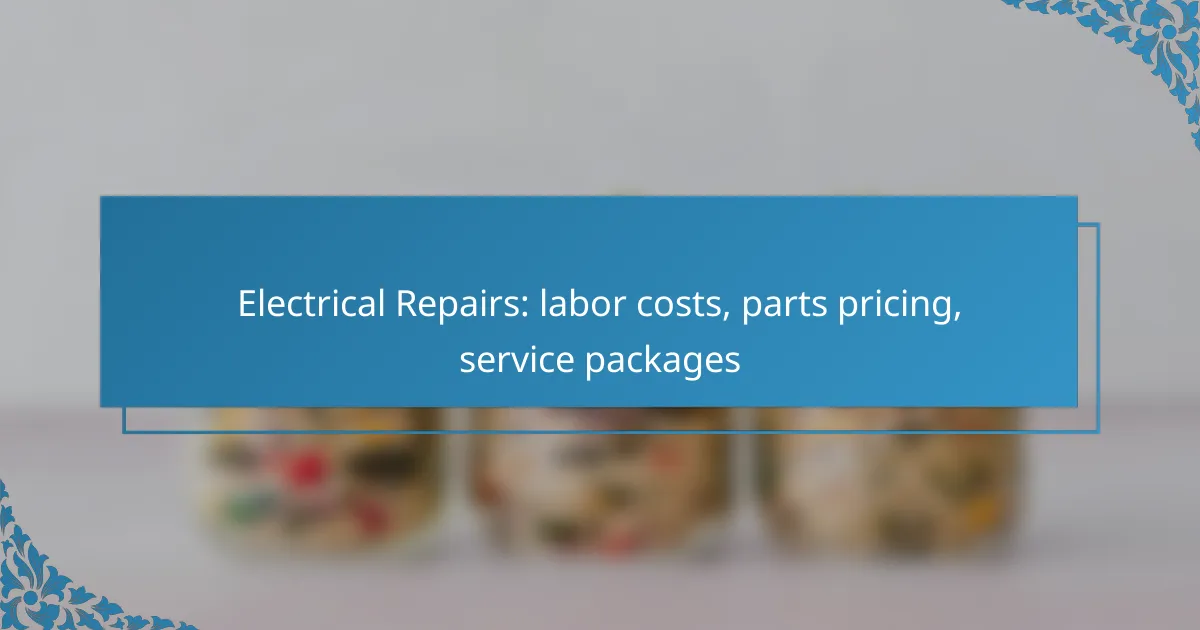When planning for electrical repairs, homeowners should be aware of the typical labor costs, which range from AUD 80 to AUD 150 per hour, influenced by the electrician’s expertise and the job’s complexity. Additionally, parts pricing can vary widely based on the components needed, making it essential to understand these costs for effective budgeting. Service packages are also available, offering various options to cater to different needs and budgets, from basic troubleshooting to extensive system upgrades.

What are the typical labor costs for electrical repairs in Australia?
The typical labor costs for electrical repairs in Australia range from AUD 80 to AUD 150 per hour, depending on the electrician’s experience and the complexity of the job. Homeowners should budget for both labor and parts when planning for electrical repairs.
Hourly rates for electricians
Hourly rates for electricians in Australia can vary significantly based on location and expertise. In metropolitan areas, rates tend to be higher, often reaching up to AUD 150 per hour, while rural areas may see rates closer to AUD 80 per hour.
Additionally, emergency services or after-hours work may incur premium charges, sometimes adding 20-50% to the standard rate. Always confirm the rate before work begins to avoid surprises.
Factors influencing labor costs
Several factors can influence labor costs for electrical repairs, including the electrician’s qualifications, the complexity of the task, and the time required to complete the job. More experienced electricians may charge higher rates, but they often provide better quality work and faster service.
The nature of the repair also plays a role; straightforward tasks like replacing a switch may cost less than complex installations or troubleshooting electrical faults. Always discuss the specifics of your project to get an accurate estimate.
Average cost range for common repairs
The average cost range for common electrical repairs in Australia varies based on the type of service. For instance, installing a new power point may cost between AUD 150 and AUD 300, while rewiring a room can range from AUD 1,000 to AUD 3,000 depending on the size and complexity.
Other common repairs, such as fixing a faulty light fixture or replacing a circuit breaker, typically fall between AUD 100 and AUD 500. It’s advisable to obtain multiple quotes from licensed electricians to ensure competitive pricing and quality service.

What are the common parts pricing for electrical repairs?
Common parts pricing for electrical repairs can vary significantly based on the type of component and the complexity of the installation. Understanding typical costs helps homeowners budget for repairs and replacements effectively.
Cost of circuit breakers
The price of circuit breakers typically ranges from $5 to $100, depending on the amperage and type. Standard single-pole breakers are generally less expensive, while double-pole breakers and specialty breakers can be pricier.
When selecting circuit breakers, consider the compatibility with your electrical panel and the specific requirements of your home’s electrical system. Always consult with a licensed electrician to ensure proper installation and compliance with local codes.
Pricing for wiring and cables
Wiring and cable costs can vary widely, generally falling between $0.10 to $2.00 per foot, depending on the type of wire. For instance, non-metallic sheathed cable (Romex) is often used for residential wiring and is typically on the lower end of the price range.
When purchasing wiring, consider the gauge and insulation type, as these factors affect both safety and performance. Always ensure that you use wiring that meets local electrical codes to avoid hazards.
Price range for light fixtures
Light fixtures can range from $20 to several hundred dollars, depending on style, brand, and features. Basic ceiling fixtures are usually more affordable, while designer or smart fixtures can be significantly more expensive.
When choosing light fixtures, consider energy efficiency and compatibility with existing wiring. LED fixtures may have a higher upfront cost but can save money in the long run through reduced energy consumption.

What service packages are available for electrical repairs?
Electrical repair service packages typically include standard and premium options, each designed to meet different customer needs and budgets. These packages can encompass a range of services, from basic troubleshooting to comprehensive electrical system upgrades.
Standard service package details
The standard service package usually covers essential repairs and maintenance tasks, such as circuit breaker replacements, wiring inspections, and minor electrical fixes. This package is ideal for homeowners seeking basic services without extensive upgrades.
Standard packages often include a fixed fee for labor, which can range from $50 to $100 per hour, depending on the region. Parts costs are additional and vary based on the specific components needed.
Premium service package offerings
Premium service packages provide a more extensive range of services, including full electrical system inspections, energy efficiency audits, and advanced installations like smart home systems. These packages are suited for customers looking to enhance their electrical systems significantly.
Pricing for premium packages can vary widely, often starting around $150 and going up to several hundred dollars, depending on the complexity of the services included. These packages may also offer warranties on parts and labor, adding extra value.
Cost comparison of service packages
When comparing standard and premium service packages, consider both the upfront costs and the long-term benefits. Standard packages are generally more affordable but may not address underlying issues that could lead to higher costs later.
Premium packages, while initially more expensive, often save money over time through improved energy efficiency and reduced repair needs. It’s advisable to assess your specific electrical needs and budget before making a decision.

How to choose the right electrician for repairs?
Choosing the right electrician for repairs involves assessing their qualifications, customer feedback, and service area. A well-informed decision can lead to quality work and a smoother repair process.
Qualifications and certifications to look for
When selecting an electrician, verify their qualifications and certifications. In Australia, electricians should hold a valid license issued by the relevant state authority, which ensures they meet safety and technical standards.
Additionally, look for certifications in specialized areas such as solar installations or home automation. These credentials indicate a higher level of expertise and can be beneficial for specific repair needs.
Customer reviews and ratings
Customer reviews and ratings provide insight into an electrician’s reliability and quality of work. Check platforms like Google, Yelp, or local trade websites for feedback from previous clients.
Pay attention to patterns in reviews, such as punctuality, professionalism, and the quality of repairs. A high rating with consistent positive comments is a good indicator of a trustworthy electrician.
Service area coverage in Australia
Ensure the electrician covers your specific area in Australia, as service availability can vary significantly. Many electricians list their service areas on their websites, so check this information before proceeding.
Consider local electricians for quicker response times and lower travel costs. If you live in a remote area, confirm their willingness to travel and any additional fees that may apply for extended distances.

What are the common electrical repair issues?
Common electrical repair issues include faulty wiring, circuit breaker problems, and malfunctioning outlets. These issues can lead to safety hazards and require prompt attention to ensure the electrical system operates efficiently and safely.
Frequent electrical faults in homes
Frequent electrical faults in homes often stem from outdated wiring, overloaded circuits, and faulty appliances. For instance, flickering lights may indicate a loose connection or a problem with the circuit breaker. Homeowners should be aware that older homes may have wiring that does not meet current safety standards.
Common faults also include tripped breakers, which can happen when too many devices draw power from a single circuit. Regular inspections can help identify these issues before they escalate into more significant problems.
Signs you need electrical repairs
Signs that indicate you may need electrical repairs include frequent circuit breaker trips, dimming or flickering lights, and outlets that feel warm to the touch. If you notice a burning smell or hear buzzing sounds from outlets or switches, these are urgent signs that require immediate professional evaluation.
Additionally, if you experience inconsistent power supply to devices or appliances, it may signal underlying electrical issues. Homeowners should not ignore these warning signs, as they can lead to more severe hazards like electrical fires.
Preventative measures for electrical issues
Preventative measures for electrical issues include regular inspections by a qualified electrician, especially in older homes. Homeowners should also avoid overloading circuits by distributing electrical devices across multiple outlets and using surge protectors where necessary.
Keeping an eye on the condition of cords and plugs is essential; frayed or damaged cords should be replaced immediately. Educating family members about safe electrical practices can further reduce the risk of electrical problems.
